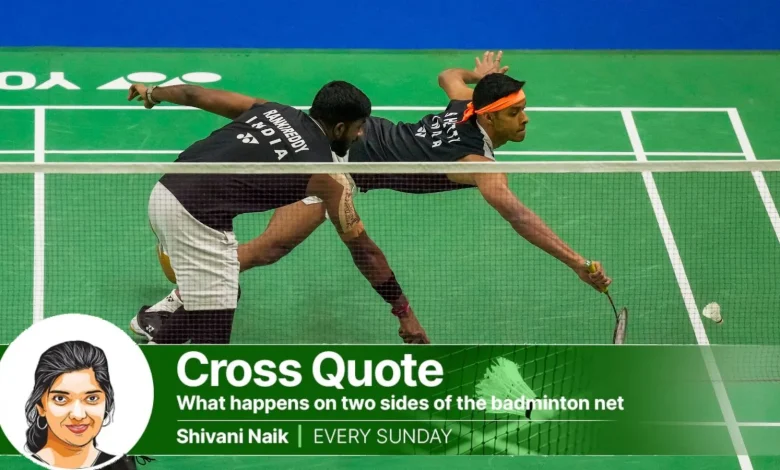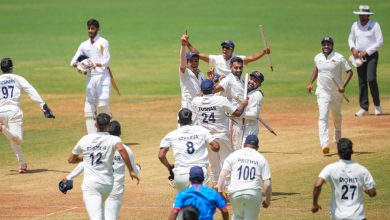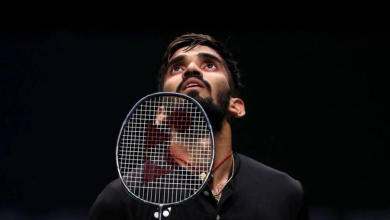Left-right combination pairs present tricky challenge for Satwiksairaj Rankireddy and Chirag Shetty | Badminton News

Some opponents irritate more than intimidate. Brushing off their annoyance can be altogether more satisfying and carries fewer frills of drama than overcoming an almighty fear. A cluck and half a grin, suffice; even scoffing is too much. No need to pen ballads to bravery here. A 21-7, 21-10 terse dismissal in 35 minutes on a fabulous Friday at Delhi got the job done.And so it was that the men’s doubles quarterfinals at India Open were wrapped up in a hurried haiku, without resorting to an overwrought Odyssey a week back. Kim Astrup and Anders Skaarup Rasmussen are somewhat a bogey team for Satwiksairaj Rankireddy and Chirag Shetty for a long time. It wasn’t that the Indians had never beaten the Danes, they famously did at the Thomas Cup. But half dozen losses lingered.
The grudge-inventory read 6-2 in favour of the left-right Astrup-Rasmussen. The Danes won two times for every time the Indians nicked one. Assorted mental games would intersperse the actual badminton — someone pushing through a serve too fast, another taking it too slow and pulling out from getting ready to receive, racquets barge-poling a shuttle from under the net, funny faces, catty celebrations and juvenile japes, the overcurrents to this rivalry bordered on the hilarious.
All this took the sting out of what was otherwise a persent puzzle for the Indians — how to counter the left-right combination.
Then it cost the Indians a World Championship medal, and that properly stung. The strain on the eyes turned into a raging headache. It upset Chirag and gave Satwik a sleepless night or three.
India’s Chirag Shetty and Satwiksairaj Rankireddy during the men’s doubles final badminton match against South Korea’s Seo Seung-jae and Kang Min-hyuk at the India Open 2024, in New Delhi, Sunday, Jan. 21, 2024. (PTI Photo)
The rivalry was as layered as a Danish pastry (also called Copenhagen Plunder in bake-speak which hugely describes the World Championships freaky Friday loss) because the third honorary Indian, or the third born-Dane, in all this, coach Mathias Boe, had played alongside Astrup once. Plentiful knowledge can make you miss the most obvious observations perhaps. The 2-6 score needed correcting. The Indians needed to overturn the World’s result this time or Boe would have raged himself into tiny Boelets of flaking, fuming fury. Satwik-Chirag were in a perceivable hurry.
The Delhi win couldn’t undo the Copenhagen miss, but a longstanding tactical answer was found. Without giving too much away, let’s just say, Astrup who tries to menace and mess around with the Indians at the net like a leprechaun’s bold mischief, was pushed back where he likes life the least, bumbling at the baseline. The Danes don’t cease to be an irritant, they’ll remain so and promise trouble should the Indians run into them at Paris, in European conditions. But at least gamewise, it’s Mischief Managed. The Indians know the relevant spell.
An unsolved problem was disentangled without a fuss. The left-right march was halted. But, was it though?
The win against Astrup-Rasmussen was the prologue to another faceoff against leftie-rightie (L-R) from another part of the world, Korean champions Seo Seung-jae and Kang Min-hyuk. The Koreans had out-L-R’d the Danes at the World Championship finals. And they stubbed out the Indians in the Delhi decider.
Any of the Top 5 pairings in men’s doubles can beat the other on a given day. The Koreans, with their calm, stringent defense though, are slightly trickier to tear down for the Indians, though a superior 4-2 count wouldn’t have anyone framing the Koreans as India’s bete noire. It’s how they suddenly pop up and prick the bubble.
There’s a context to the loss. The Indians were a tad tired playing back-to-back finals on successive Sundays, that’s 10 matches in 13 days, winning 8, including against Top 5 pairings. Excellent consency, not-so-great finals conversion numbers. Unlike Malaysia, these were slow conditions in Delhi, so the Indians couldn’t just blitz through and bulldoze past the Koreans.
Asian Games Gold Medall, Satwiksairaj Rankireddy and Chirag Shetty from India in action against Kim Astrup & Anders Skaarup Rasmussen of Denmark during their 21-7, 21-10 win in quarter-finals at Yonex-Sunrise India Open 2024 at IG Stadium, New Delhi on Friday. (BAI Media)
Chirag is exceptional at the net, but the southpaw Seo Seung-jae can be even more lethal in the front, owing to his below the tape defense and racquet work. He works up wicked angles, without any hint of a menace. Malaysian Aaron Chia can be intimidating and fancy at the net, though his speed has hugely dipped. Seo on the other hand, is disarmingly quiet but doubly busy, and doesn’t overwhelm with speed in flat attacks. With his mix of varying pace, placement and power, he nullified the Indian attack and won the net battle that day.
Denying Indians openings from the front, the Koreans opened up a huge lead in the second set, putting the Indians under pressure. Satwik-Chirag love dominating the initial skirmish – the first two-three shots. But both Koreans served exceptionally well, and not unlike the Chinese Liang-Wang, used a mixed bag of flat, spin and tumble serves to keep the Indians guessing.
The Korean service pushed the Indians a few inches back in their receiving stance, and while the flat serve is easy to counter if you can guess it’s coming, it can pose problems if you are not prepared to budge from the net. But it was the longer drives and the Korean lifts into the back court that truly destabilized the Indians as Seo opened up the court.
Unlike Astrup who loves to stomp about at the net but can be rendered clueless at the back, Seo has also been a fine mixed doubles player, and if he’s 100 percent good at the net, from the back court he’s 90 percent at least. His baseline play is quite outstanding and under that middle partitioned mop of curls, is a brilliant brain that seeks out gaps on court with his deceptive defense collecting plenty of points as winners.
India’s Satwiksairaj Rankireddy and Chirag Shetty celebrate after defeating South Korea’s Kang Min Hyuk and Seo Seung Jae in the men’s doubles semifinal of the Malaysia Open. (AP Photo)
The leftie-rightie pairing doesn’t just help in defensive court coverage. Their retrieves down the middle when Seo plays on the right in a rotation and racquets drop down for pickups that can withstand bombarding of the Indian attack. When they fan out and he switches left with flitting footwork, Seo works up some deluding beguiling deception from the flanks, and the returns can send both opponents scrambling after one shuttle.
The rare leftie angles are an innate advantage, and Satwik-Chirag will do well to stock their sparring troops with a bunch of southpaws, because Seo takes getting used to, especially if you’ve been routinely whipping the righties with aplomb, day after day, and the leftie suddenly fetches up.
Seo-Kang are not overtly intimidating, nor irritating like Astrup who unfailingly raises the tension levels or Rasmussen who remains unflappable but can trigger a frenzy in Satwik. But the Koreans drove the Indians into tentative back court play with their L-R mixed bag of tactics. From times of Park Joo-bong to Lee Yong-dae, Korean doubles can weave elaborate patterns that don’t look threatening until it’s too late. Seo-Kang won tactically in Delhi.
Mercifully it wasn’t at the All England or Olympics, and the Indians will be ready next time. Losing to the Koreans seldom hurts or bruises or annoys. That might well be the biggest trick the devil pulls off – not a soul in Delhi could’ve foretold the 11-21, 18-21 scoreline, to follow after the first set was a 21-15 Indian stroll.







